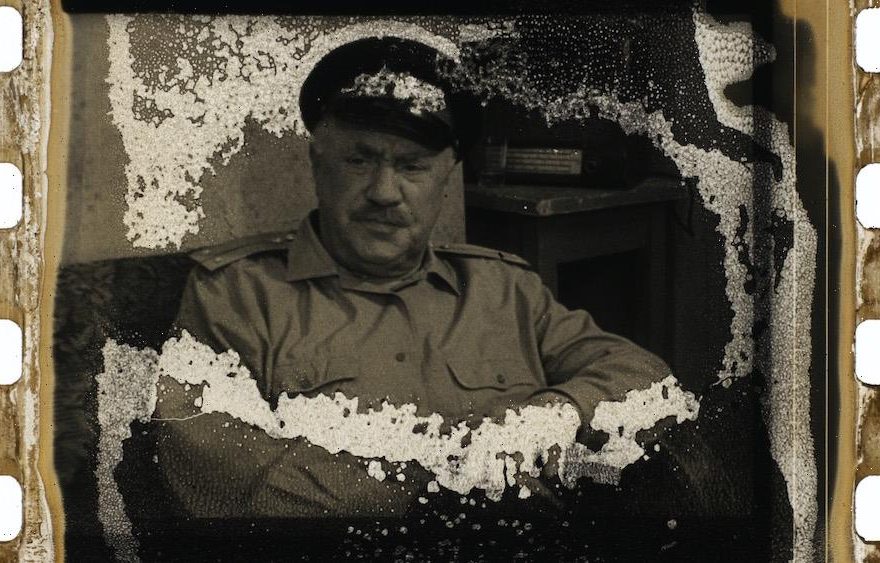Bill Morrison makes movies out of fragments of other movies, giving new life to ghostly scraps of an earlier time. Whereas most film conservationists aspire to restoring lost and degraded films to their original glory, Morrison sees beauty in the decay — the underlying premise of his mesmerizing avant-garde super-cut “Decasia,” released in 2002, and a key attraction of his latest collage feature, “The Village Detective: A Song Cycle,” which spends long minutes projecting what remains of four reels of celluloid recovered from the Atlantic by an Icelandic fishing trawler.
A decade after “Decasia,” Morrison reached even wider recognition with “Dawson City: Frozen Time,” wherein a stockpile of century-old 35mm prints unearthed in northern Canada — an end-of-the-line Klondike gold rush outpost that had become a de-facto graveyard for traveling films — served as the raw material for a rumination on a lost era, both the fortune-seekers who sought the frontier and the remarkable discovery of these ephemeral entertainments that had miraculously outlived them. “Dawson City” proved so thrilling in part because there was clearly treasure amid the detritus, and Morrison put in the effort to sift through and contextualize what had been found.
But his “Village Detective” is a different animal. What Morrison doesn’t reveal until rather late — but which seems fairly obvious from the outset — is that the discovery isn’t especially precious: a partial copy of the popular Soviet film “Derevenskiy detektiv” from 1969, which had somehow fallen overboard and settled on the bottom of the sea. While the film may seem exotic enough to Western eyes, Russian audiences surely recognize it as a relatively uninteresting find, which could potentially spoil the effect, the way Turkish speakers can spot the twist in “The Usual Suspects” by the clues contained in Keyser Soze’s name.
The recovered film print is hardly worthless, even if, I suspect, Morrison plays the scenes of an Icelandic archivist’s care in unspooling it for a kind of tongue-in-cheek absurdity. One of the perverse aspects of film preservation is that so many valuable artifacts are allowed to perish, while considerable effort and expense are spent salvaging those fragments that fall into the right hands. There’s no good reason to restore this copy of “Derevenskiy detektiv” —fool’s gold compared to the motherlode of “Dawson City” — considering people can easily watch the film in its undegraded entirety on YouTube. Still, the rust-stained and badly distorted print does hold interest for Morrison, who sees beauty in the damage, and a certain poetry in its banality.
“Derevenskiy detektiv” stars Soviet actor Mikhail Zharov as a vaguely Columbo-esque small-town police officer, tasked with helping a musician locate his stolen accordion. It hardly seems like a pressing case, but the missing instrument unlocks a larger mystery, and the same could be said for the way Morrison uses the film within his film — as a classic MacGuffin: the sought-after prize that compels the characters, while giving audiences something on which to focus their attention. In “Derevenskiy detektiv,” something has gone missing, but in the film that encapsulates it, “The Village Detective,” an artifact has been found, leaving us to ask: How did it wind up on the floor of the Atlantic Ocean, and what, if anything, can this curious message in a bottle tell us?
Morrison opts to focus on Zharov, the film’s star, pulling footage from seven decades of the actor’s career (these all clearly identified and presented in best-possible condition, whereas “Derevenskiy detektiv” is sampled in its more hypnotic sea-brined state). In the director’s mind, Zharov’s career may have followed a similar trajectory to this print — well-loved in its time, but since forgotten/abandoned — and so he dedicates himself to reconstructing it through a series of loose yet illuminating connections.
The logic of the resulting meta-narrative isn’t always clear, and can actually be oddly shallow at times, as when he spotlights Zharov playing the accordion in three other films. In such playful juxtapositions, Zharov’s various roles seem to be speaking to one another: Here he is searching for a musical instrument in “Derevenskiy detektiv,” and there he is using one in various other movies, including the Soviet Union’s first sound film, “Road to Life,” in which Zharov was the first person to sing in Russian on screen. In another overly literal association, Morrison commissions a meditative score from David Lang, composed for the accordion.
A project like this might have seemed fairly special a decade or more ago, but these days, amateur editors are doing surprisingly sophisticated montages for private events or public YouTube consumption. Music seems to be the magic tool across such undertakings, allowing remix artists to suggest a false continuity across disparate media: A well-chosen tune can smooth over the otherwise jarring splices between source materials. Morrison dubs this film “A Song Cycle,” but there are no vocals. His narration is delivered entirely by text, and there’s an overall clunkiness to the format that doesn’t feel especially lyrical, as if the mysteries Morrison is investigating are too amorphous or ill-defined for the movie to articulate.
Source: Read Full Article
